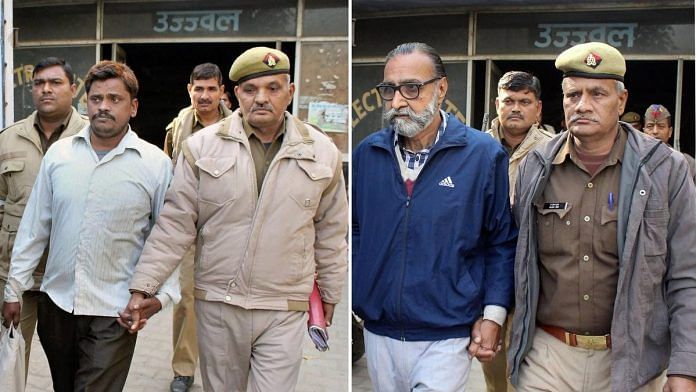New Delhi: She went missing on the evening of 8 February, 2005. Nearly two years later, the 14-year-old girl’s bones, innerwear and dupatta (scarf) were recovered from a dumping ground behind the infamous house number ‘D-5’ in Nithari village in Sector 31, Noida. A probe eventually led investigators to suspect that she had been raped and murdered.
Hers was one of the 16 cases in which the CBI filed a chargesheet as part of its probe into the Nithari killings, naming Surinder Koli — the domestic help of Moninder Pandher, the owner of house number ‘D-5’ — as the accused.
On Monday, the Allahabad High Court acquitted Koli in 12 cases and Pandher in two. While this means that Pandher will now walk free since he has been acquitted in all of the six cases lodged against him, Koli will remain behind bars owing to a Supreme Court judgment upholding his conviction in the rape and murder case of the 14-year-old girl.
A special CBI court had in 2009 sentenced both Koli and Pandher to death in this case. The Allahabad High Court later acquitted Pandher, while upholding Koli’s sentence. Koli then challenged the verdict in the Supreme Court, which upheld the verdict of the high court.
14-year-old girl’s rape-murder
Nearly five months after their daughter went missing from Noida, parents of the 14-year-old girl filed a missing persons report on 20 July, 2005.
In December 2006, her mother — upon hearing that skeletal remains had been found behind a house in Nithari village — rushed to the spot and identified her personal effects. A DNA test confirmed that among the remains recovered were those of the 14-year-old girl.
Both Koli and Pandher were arrested by the Noida police on 29 December. Not long after that, the case was transferred to the CBI in January 2007. The CBI registered an FIR in the case involving the minor girl on 11 January, 2007. It later chargesheeted Koli under sections of the Indian Penal Code (IPC) pertaining to kidnapping, rape and murder.
While Pandher was not named in the CBI chargesheet in this case, he was summoned by the court under section 319 of the CrPC (when in court of inquiry or trial, it appears from evidence that a person not accused has committed any offence for which he or she should be tried together with the accused) and was charged under the same IPC sections as Koli. Pandher was also charged with criminal conspiracy by the central agency.
The confession Koli made in the presence of a magistrate, along with the skeletal remains recovered by investigators, formed the crux of the evidence on the basis of which a special CBI court sentenced him to death for the rape and murder of the minor — a sentence that was upheld by both the Allahabad High Court and later the Supreme Court of India.
The apex court, when it upheld Koli’s death sentence in 2011, noted that his was a “rarest of the rare” case, and that he should be shown “no mercy”. It also noted that house number ‘D-5’ in Nithari village, Noida, had become a “virtual slaughter house”.
“Doctors at AIIMS have put the parts of the deceased girls which have been recovered by doctors of AIIMS together. These bodies have been recovered in the presence of the doctors of AIIMS as pointed out by the accused Surendra Koli. Thus, recovery is admissible under Section 27 of the Evidence Act,” the two-judge bench of the Supreme Court comprising Justices Markandey Katju and Gyan Sudha Misra noted at the time.
Further, in a confession he gave before a magistrate on 1 March, 2007, Koli described in “great detail” how he “killed” his victims after “luring them inside the house by strangling them”. He also said he would “chop up and eat up their body parts after cooking them”.
Such a confession made in the presence of a magistrate under Section 164 of the CrPC can be used as evidence in a court of law.
On Koli’s acquittal in 12 cases, Advocate Payoshi Roy, one of his legal counsels, told ThePrint Monday that the prosecution’s case was based entirely on recoveries made by investigators and a confession recorded in 2007.
“Both pieces of evidence have been rejected by the Allahabad High Court. The high court has clearly stated that the confession was fabricated and it was contorted by the CBI and he was tortured into giving this confession and the recovery of the bones were fabricated. These human remains were recovered from a dump yard between three houses. We intend to now challenge his death penalty in the Supreme Court now,” said Roy.
(Edited by Amrtansh Arora)
Also Read: From Raman Raghav to Cyanide Mallika, a look at India’s most notorious serial killers



